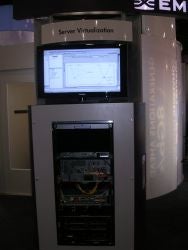

It may not be glossy or nearly as exciting as server virtualization, but storage and a strategy to deal with it is vital to any enterprise. Storage, perhaps in a effort to make it sound more compelling, is now referred to as “data management” or “information management.”
Storage vendors may not have been front and center at VMworld, but their presence was strong and not coincidental.
Data management lends itself well to virtualization, and as a result, as enterprises virtualize their infrastructure one of the first areas to be virtualized is storage. It was not surprising, therefore, that there was not shortage of storage companies exhibiting at VMworld last week.
Commvault, which remains best-known for its backup technologies was at the show. Last July, it released version 7.0 of the Simpana Singular Information Management Architecture suite of products designed to provide a solution to the complexities of backup archiving that goes beyond the physical. It currently features Application modules for Data Protection, Archive, Replication, Resource Management and Search snap on to a base layer that “allows for one singular consolidated pool,” Product Manager Zahid Ilkal told ServerWatch.
It does this by managing everything as a single virtual pool. Ilkal explained that enterprises can set it up so the most relevant data is spinning on disk for easy access.
Ilkal said many customers are looking at virtualization. It’s not surprising, therefore, that the company offers an add-on module for virtual servers, and the vast majority of customers are buying it. It enables users to “back up and dedupe a virtual server, regardless of location, and manage the physical and virtual together.”
Modules are available for Hyper-V, VMware and Xen environments. Not surprisingly, VMware is the most popular overall, and Hyper-V is having the most success with SMBs.
Emulex, meanwhile focuses on connectivity, and its latest focus is Fibre Channel over Ethernet (FCOE). Its big news for the week was that VMware-certified FCOE-based converged network adapters (CNAs) for use across ESX server environments.
CNAs provide a host of connectivity options for virtualization environments. NPIV support, for example, is designed to allow customers to virtualize SAN connections to give each virtual machine independent access to its own protected storage. The benefits to this are readily apparent.
Emulex’s strategy is one of redundancy — for lack of a better pun. The vendor also revealed that its 8Gb/s HBAs have been certified for use within the new Citrix XenServer 5 virtualization software.
 |
|
Emulex’s Fibre Channel Over Ehernet Converged Network Adapters in Action (Click for larger image) |
This is a smart move when you consider that VMware’s recent vStorage initiative and the fact that EMC is its parent company.
EMC may be a major player when it comes to selling storage hardware, but it is hardly alone. NetApp is a $3 billion data management company, which has been on board with virtualization for some time. Richard Clifton, senior vice president and general manager, virtualization and grid infrastructure BU, said the company saw this coming a long time ago, and thus made virtual storage pools part of the product several years ago.
He also said he sees the key to a successful virtualization endeavor not being about servers or storage but about the entire infrastructure, and “with infrastructure virtualization, the expectations for the server extend beyond it.”
Although NetApp’s solutions “allow half as much space to solve the same problem,” according to Phil Brotherton, vice president and general manager enterprise application business unit, he cautioned against mixing virtual storage and virtual servers on the same hardware, as separate storage pools make for a better operating environment.
So what’s next, now that the storage industry has drank the virtual Kool-Aid?
Composite apps, according to Clifton. Composite apps are those that enable application virtualization. Clifton believes there is a strong correlation between them and desktop enablement because they make the economics of desktop virtualization make sense.
And when desktop virtualization takes off, virtual storage (or data management or information management — call it what you will), will take off even further.
Amy Newman is the managing editor of ServerWatch. She has been covering the virtualization market since 2001 and recently returned from VMworld.
Property of TechnologyAdvice. © 2025 TechnologyAdvice. All Rights Reserved
Advertiser Disclosure: Some of the products that appear on this site are from companies from which TechnologyAdvice receives compensation. This compensation may impact how and where products appear on this site including, for example, the order in which they appear. TechnologyAdvice does not include all companies or all types of products available in the marketplace.